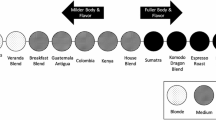Abstract
This paper introduces a tool called the designer preference modeler (DPM) that analyzes the designer’s decision making during concept evaluation, and constructs a designer preference model to be used for evaluation of automatically generated design alternatives. The method is based on establishing an interaction between a designer and a computational synthesis tool during conceptual design. The synthesis software generates design alternatives using a catalog of design knowledge formulated as grammar rules which describe how electromechanical designs are built. DPM carefully selects a set from these alternatives and presents it to the designer for evaluation. The designer’s evaluations are translated into a preference model that is subsequently used to search the solution space for best designs. Application of the method to the design of a consumer product shows DPM’s range of capabilities.

















Similar content being viewed by others
References
Altshuller G (1984) Creativity as an exact science. Gorden and Breach, Luxembourg
Bohm M, Stone R (2004) Product design support: exploring a design repository system. In: Proceedings of the IMECE’04, IMECE2004-61746, Anaheim, CA
Bracewell RH, Sharpe JEE (1996) Functional descriptions used in computer support for qualitative scheme generation—Schemebuilder. AIEDAM 10(4):333–346
Bryant C, Stone R, McAdams D, Kurtoglu T, Campbell M (2005) A computational technique for concept generation. In: ASME IDETC’05. Long Beach, CA
Cagan J (2001) Engineering shape grammars. In: Antonsson EK, Cagan J (eds) Formal engineering design synthesis. Cambridge University Press, London
Campbell M, Cagan J, Kotovsky K (2000) Agent-based synthesis of electro-mechanical design configurations. J Mech Des 122(1):61–69. doi:10.1115/1.533546
Chakrabarti A, Bligh TP (1996) An approach to functional synthesis of mechanical design concepts: theory, applications, and merging research issues. AIEDAM 10:313–331
Hazelrigg G (1996) Systems engineering: an approach to information-based design. Prentice Hall, Upper Saddle River
Keeney RL, Raiffa H (1976) Decisions with multiple objectives: preferences and value tradeoffs. Wiley, New York
Kurtoglu T, Campbell M, Bryant C, Stone R, McAdams D (2005), “Deriving a Component Basis for Computational Functional Synthesis” Proceedings of ICED’05, Melbourne, Australia
Kurtoglu T, Campbell MI, Gonzales J, Bryant CR, McAdams DA, Stone RB (2005) Capturing empirically derived design knowledge for creating conceptual design configurations. In: Proceedings of the DETC2005, September. Long Beach, California, pp 24–28
Linsey JS, Green MG, Murphy JT, Wood KL, Markman AB (2005) Collaborating to success: an experimental study of group idea generation techniques. In: Proceedings of the DETC2005, Long Beach, CA
McAdams D, Wood K (2000) Quantitative measures for design by analogy, DETC2000/DTM–14562. In: Proceedings of DETC2000, Balitmore, MD
Messac A (1996) Physical programming: effective optimization for computational design. AIAA J 34(1):149–158. doi:10.2514/3.13035
Moss J, Cagan J, Kotovsky k (2004) Learning from experience in an agent based design system. Res Eng Des 15:77–92
Myers KL, Zumel NB, Gracia P (1999) Automated rationale capture for the detailed design process. In: 11th Conference on Innovative Applications of AI
Osborn A (1957) Applied imagination. Scribner, New York
Pahl G, Wallace K (2002) Using the concept of functions to help synthesize solutions. Springer, London
Pahl G, Beitz W (1996) Engineering design—a systematic approach, 2nd edn. Springer, London
Pugh S (1991) Total design: integrated methods for successful product engineering. Addison-Wesley Publishing Company, Workingham
Rawson K, Stahovich TF (2006) A method for inferring design rules with explicit bounds of applicability. In: Proceedings of the ASME IDETC’06. Philadelphia, PA
Saaty T (1980) The analytic hierarchy process. McGraw-Hill, New York
Simon HA (1969) The sciences of the artificial. The MIT Press, Cambridge
Stiny G (1981) A note on the description of designs. Environ Plan B 8:257–267. doi:10.1068/b080257
Stahovich TF (2000) LearnIT: an instance based approach to learning and using design strategies. ASME J Mech Des 122(3):249–256. doi:10.1115/1.1288216
Stone R, Wood K (2000) Development of a functional basis for design. J Mech Des 122:359–370. doi:10.1115/1.1289637
Thurston DL (1991) A formal method for subjective design evaluation with multiple attributes. Res Eng Des 3:105–122. doi:10.1007/BF01581343
Ullman D (1995) The mechanical design process. McGraw-Hill, New York
Wood KL, Antonsson EK, Beck JL (1990) Representing imprecision in engineering design: comparing fuzzy and probability calculus. Res Eng Des 1(3–4):187–203
Zwicky P (1969) Discovery, invention, research through morphological analysis. McMillan, New York
Author information
Authors and Affiliations
Corresponding author
Appendix: Grammar rules used in the design of the “bread slicer” product
Rights and permissions
About this article
Cite this article
Kurtoglu, T., Campbell, M.I. An evaluation scheme for assessing the worth of automatically generated design alternatives. Res Eng Design 20, 59–76 (2009). https://doi.org/10.1007/s00163-008-0062-1
Received:
Accepted:
Published:
Issue Date:
DOI: https://doi.org/10.1007/s00163-008-0062-1





